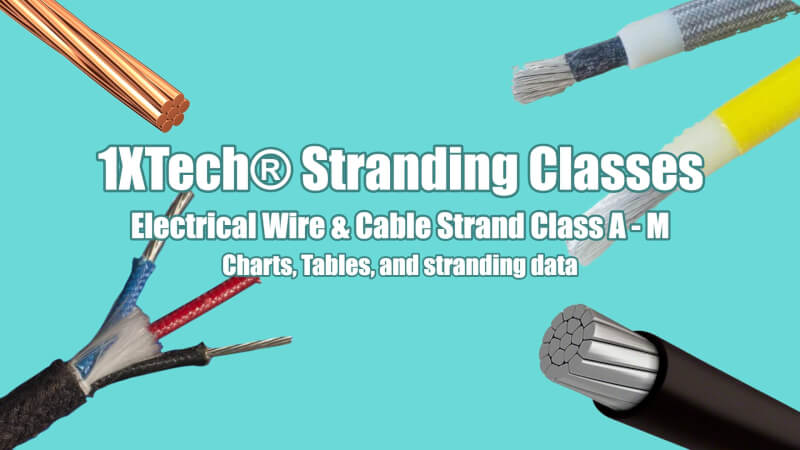STRANDING CLASSES CHART/TABLE 1XTECH® ELECTRICAL WIRE & CABLE CONDUCTOR STRAND TYPES (Class A – M)
1X Technologies manufactures and sells copper and aluminum electrical and networking (electronic) wire & cable with multiple options of stranding classes for your conductor. Below you will find information on strands from class A (Solid) through class M (Extra flexible). Please contact us if you need more information or if you require a quote on any type of wire & cable. Below you will find reference charts and tables that will help you with most of your standing questions, and you may contact us if you need more information. Thank you.
| TYPICAL WIRE & CABLE STRANDS FROM 1X TECHNOLOGIES | |||||||
| AWG | |||||||
| Sizes | Solid | Class B | Class C | Class H | Class K | Class L | Class M |
| 26 | .0167 | – | – | – | – | 7/.008 | 7/.0063 |
| 24 | .0201 | 7/.0080 | 19/.0046 | – | – | 7/.008 | – |
| 22 | .0253 | 7/.0100 | 19/.0058 | – | 7/.010 | 7/.008 | 19/.0063 |
| 20 | .0320 | 7/.0126 | 19/.0080 | – | 10/.010 | 16/.008 | 26/.0063 |
| 19 | .03589 | – | – | – | – | – | – |
| 18 | .0403 | 7/.0152 | 19/.0100 | – | 16/.010 | 26/.008 | 41/.0063 |
| 16 | .0508 | 7/.0192 | 19/.0113 | – | 26/.010 | 41/.008 | 65/.0063 |
| 14 | .0641 | 7/.0242 | 19/.0147 | – | 41/.010 | 65/.008 | 104/.0063 |
| 12 | .0808 | 7/.0305 | 19/.0185 | – | 65/.010 | 104/.008 | 168/.0063 |
| 10 | .1019 | 7/.0385 | 19/.0234 | – | 104/.010 | 165/.008 | 259/.0063 |
| 9 | .1144 | 7/.0432 | 19/.0262 | 133/.0099 | 133/.010 | 336/.0063 | |
| 8 | .1285 | 7/.0486 | 19/.0295 | 133/.0111 | 168/.010 | 420/.0063 | |
| 6 | 7/.0612 | 19/.0372 | 133/.0142 | 266/.010 | 665/.0063 | ||
| 4 | 7/.0772 | 19/.0469 | 133/.0179 | 420/.010 | 1064/.0063 | ||
| 2 | 7/.0974 | 19/.0591 | 133/.0223 | 665/.010 | 1666/.0063 | ||
| 1 | 19/.0664 | 37/.0476 | 259/.0180 | 836/.010 | 2107/.0063 | ||
| 1/0 | 19/.0745 | 37/.0534 | 259/.0202 | 1064/.010 | 2646/.0063 | ||
| 2/0 | 19/.0837 | 37/.0600 | 259/.0227 | 1323/.010 | 3325/.0063 | ||
| 3/0 | 19/.0940 | 37/.0673 | 259/.0255 | 1666/.010 | 4256/.0063 | ||
| 4/0 | 19/.1055 | 37/.0756 | 259/.0286 | 2107/.010 | 5320/.0063 | ||
| 250 MCM | 37/.0822 | 61/.0640 | 427/.0242 | 2499/.010 | 6384/.0063 | ||
| 300 MCM | 37/.0900 | 61/.0701 | 427/.0265 | 2989/.010 | 7581/.0063 | ||
| 350 MCM | 37/.0973 | 61/.0757 | 427/.0287 | 3458/.010 | 8806/.0063 | ||
| 400 MCM | 37/.1040 | 61/.0810 | 427/.0306 | 3990/.010 | 10101/.0063 | ||
| 500 MCM | 37/.1162 | 61/.0905 | 427/.0342 | 5054/.010 | 12691/.0063 | ||
| 750 MCM | 61/.1109 | 91/.0908 | 427/.0417 | 7581/.010 | 18788/.0063 | ||
| 1000 MCM | 61/.1280 | 91/.1048 | 427/.0484 | 10101/.010 | 25193/.0063 | ||
| Note: For UL listed or recognized 200C cables requiring 200C and tin-coated copper strands, each strand diameter should be 015” or larger. | |||||||
1XTECH® ELECTRICAL WIRE & CABLE STRANDING CLASSES & TYPES
Types of Stranding
If a cable with a stranded conductor seems to be the appropriate choice for your application, you then need to consider the type of stranding. Although most constructions are specified by regulatory agencies, it is helpful to know some basic information about each type.
| Bunched: Strands are gathered together with no particular design or arrangement. This is the least expensive type of stranding as it involves the least amount of time and labor. Bunched stranding provides great flexibility. | |
| Concentric: Strands are arranged in a circular pattern. Each layer alternates direction and has an increasing lay length (the center strand is longest). Concentric stranding is mostly chosen for its mechanical strength and crush resistance. | |
| Unilay: Strands are arranged in a circular pattern, but all layers are twisted in the same direction and share the same lay length. A unilay arrangement is lightweight and allows for a small diameter. | |
| Rope lay: Strands are arranged into cabled groups. Each group usually consists of 7, 13, 19, or 27 strands since those counts can be gathered into a circular configuration easily. Rope lay is the most flexible type of stranding and is generally found in cables size 10 AWG and larger. |
Custom Stranding
Additionally, you may require custom stranding such as a combination of the above like a Bunch Strand – Rope Lay, or Equilay, which offers Strands similar to those in concentric stranding, but lay length is the same for each layer. If you need a custom Stranding just let us know.
Common Questions we receive every day on wire & cable Stranding Classes
Do you have any of these common questions? If so, contact us now and we will be happy to assist you.
- What are the stranding classes used for?
- What class of wire is used for wire stranding?
- What is stranding in cable construction?
- What is a stranded conductor?

